Datastage parallel stages groups
DataStage and QualityStage stages are grouped into the following logical sections:
- General objects
- Data Quality Stages
- Database connectors
- Development and Debug stages
- File stages
- Processing stages
- Real Time stages
- Restructure Stages
- Sequence activities
Please refer to the list below for a description of the stages used in DataStage and QualityStage.
We classified all stages in order of importancy and frequency of use in real-life deployments (and also on certification exams). Also, the most widely used stages are marked bold or there is a link to a subpage available with a detailed description with examples.
DataStage and QualityStage parallel stages and activities
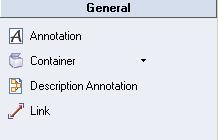
General elements
- Container (can be private or shared) - the main outcome of having containers is to simplify visually a complex datastage job design and keep the design easy to understand.
- Annotation is used for adding floating datastage job notes and descriptions on a job canvas. Annotations provide a great way to document the ETL process and help understand what a given job does.
- Description Annotation shows the contents of a job description field. One description annotation is allowed in a datastage job.
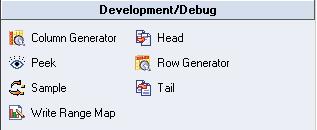
Debug and development stages
- Row generator produces a set of test data which fits the specified metadata (can be random or cycled through a specified list of values). Useful for testing and development.
- Column generator adds one or more column to the incoming flow and generates test data for this column.
- Peek stage prints record column values to the job log which can be viewed in Director. It can have a single input link and multiple output links.
- Sample stage samples an input data set. Operates in two modes: percent mode and period mode.
- Head selects the first N rows from each partition of an input data set and copies them to an output data set.
- Tail is similiar to the Head stage. It select the last N rows from each partition.
- Write Range Map writes a data set in a form usable by the range partitioning method.
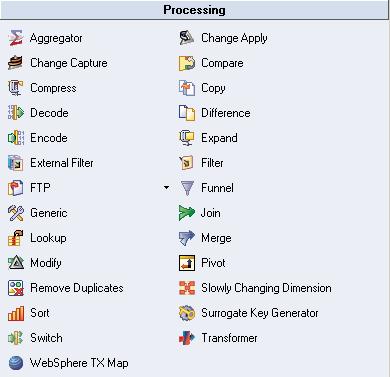
Processing stages
- Aggregator joins data vertically by grouping incoming data stream and calculating summaries (sum, count, min, max, variance, etc.) for each group. The data can be grouped using two methods: hash table or pre-sort.
- Copy - copies input data (a single stream) to one or more output data flows
- FTP stage uses FTP protocol to transfer data to a remote machine
- Filter filters out records that do not meet specified requirements.
- Funnel combines mulitple streams into one.
- Join combines two or more inputs according to values of a key column(s). Similiar concept to relational DBMS SQL join (ability to perform inner, left, right and full outer joins). Can have 1 left and multiple right inputs (all need to be sorted) and produces single output stream (no reject link).
- Lookup combines two or more inputs according to values of a key column(s). Lookup stage can have 1 source and multiple lookup tables. Records don't need to be sorted and produces single output stream and a reject link.
- Merge combines one master input with multiple update inputs according to values of a key column(s). All inputs need to be sorted and unmatched secondary entries can be captured in multiple reject links.
- Modify stage alters the record schema of its input dataset. Useful for renaming columns, non-default data type conversions and null handling
- Remove duplicates stage needs a single sorted data set as input. It removes all duplicate records according to a specification and writes to a single output
- Slowly Changing Dimension automates the process of updating dimension tables, where the data changes in time. It supports SCD type 1 and SCD type 2.
- Sort sorts input columns
- Transformer stage handles extracted data, performs data validation, conversions and lookups.
- Change Capture - captures before and after state of two input data sets and outputs a single data set whose records represent the changes made.
- Change Apply - applies the change operations to a before data set to compute an after data set. It gets data from a Change Capture stage
- Difference stage performs a record-by-record comparison of two input data sets and outputs a single data set whose records represent the difference between them. Similiar to Change Capture stage.
- Checksum - generates checksum from the specified columns in a row and adds it to the stream. Used to determine if there are differencies between records.
- Compare performs a column-by-column comparison of records in two presorted input data sets. It can have two input links and one output link.
- Encode encodes data with an encoding command, such as gzip.
- Decode decodes a data set previously encoded with the Encode Stage.
- External Filter permits speicifying an operating system command that acts as a filter on the processed data
- Generic stage allows users to call an OSH operator from within DataStage stage with options as required.
- Pivot Enterprise is used for horizontal pivoting. It maps multiple columns in an input row to a single column in multiple output rows. Pivoting data results in obtaining a dataset with fewer number of columns but more rows.
- Surrogate Key Generator generates surrogate key for a column and manages the key source.
- Switch stage assigns each input row to an output link based on the value of a selector field. Provides a similiar concept to the switch statement in most programming languages.
- Compress - packs a data set using a GZIP utility (or compress command on LINUX/UNIX)
- Expand extracts a previously compressed data set back into raw binary data.
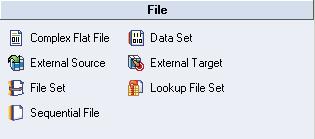
File stage types
- Sequential file is used to read data from or write data to one or more flat (sequential) files.
- Data Set stage allows users to read data from or write data to a dataset. Datasets are operating system files, each of which has a control file (.ds extension by default) and one or more data files (unreadable by other applications)
- File Set stage allows users to read data from or write data to a fileset. Filesets are operating system files, each of which has a control file (.fs extension) and data files. Unlike datasets, filesets preserve formatting and are readable by other applications.
- Complex flat file allows reading from complex file structures on a mainframe machine, such as MVS data sets, header and trailer structured files, files that contain multiple record types, QSAM and VSAM files.
- External Source - permits reading data that is output from multiple source programs.
- External Target - permits writing data to one or more programs.
- Lookup File Set is similiar to FileSet stage. It is a partitioned hashed file which can be used for lookups.
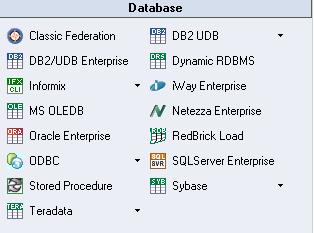
Database stages
- Oracle Enterprise allows reading data from and writing data to an Oracle database (database version from 9.x to 10g are supported).
- ODBC Enterprise permits reading data from and writing data to a database defined as an ODBC source. In most cases it is used for processing data from or to Microsoft Access databases and Microsoft Excel spreadsheets.
- DB2/UDB Enterprise permits reading data from and writing data to a DB2 database.
- Teradata permits reading data from and writing data to a Teradata data warehouse. Three Teradata stages are available: Teradata connector, Teradata Enterprise and Teradata Multiload
- SQLServer Enterprise permits reading data from and writing data to Microsoft SQLl Server 2005 amd 2008 database.
- Sybase permits reading data from and writing data to Sybase databases.
- Stored procedure stage supports Oracle, DB2, Sybase, Teradata and Microsoft SQL Server. The Stored Procedure stage can be used as a source (returns a rowset), as a target (pass a row to a stored procedure to write) or a transform (to invoke procedure processing within the database).
- MS OLEDB helps retrieve information from any type of information repository, such as a relational source, an ISAM file, a personal database, or a spreadsheet.
- Dynamic Relational Stage (Dynamic DBMS, DRS stage) is used for reading from or writing to a number of different supported relational DB engines using native interfaces, such as Oracle, Microsoft SQL Server, DB2, Informix and Sybase.
- Informix (CLI or Load)
- DB2 UDB (API or Load)
- Classic federation
- RedBrick Load
- Netezza Enterpise
- iWay Enterprise
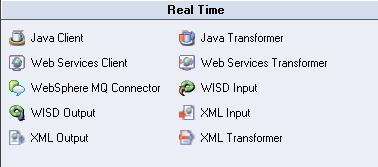
Real Time stages
- XML Input stage makes it possible to transform hierarchical XML data to flat relational data sets
- XML Output writes tabular data (relational tables, sequential files or any datastage data streams) to XML structures
- XML Transformer converts XML documents using an XSLT stylesheet
- Websphere MQ stages provide a collection of connectivity options to access IBM WebSphere MQ enterprise messaging systems. There are two MQ stage types available in DataStage and QualityStage: WebSphere MQ connector and WebSphere MQ plug-in stage.
- Web services client
- Web services transformer
- Java client stage can be used as a source stage, as a target and as a lookup. The java package consists of three public classes: com.ascentialsoftware.jds.Column, com.ascentialsoftware.jds.Row, com.ascentialsoftware.jds.Stage
- Java transformer stage supports three links: input, output and reject.
- WISD Input - Information Services Input stage
- WISD Output - Information Services Output stage
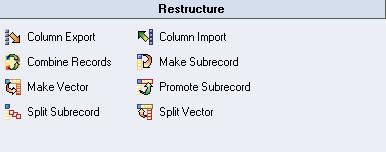
Restructure stages
- Column export stage exports data from a number of columns of different data types into a single column of data type ustring, string, or binary. It can have one input link, one output link and a rejects link.
- Column import complementary to the Column Export stage. Typically used to divide data arriving in a single column into multiple columns.
- Combine records stage combines rows which have identical keys, into vectors of subrecords.
- Make subrecord combines specified input vectors into a vector of subrecords whose columns have the same names and data types as the original vectors.
- Make vector joins specified input columns into a vector of columns
- Promote subrecord - promotes input subrecord columns to top-level columns
- Split subrecord - separates an input subrecord field into a set of top-level vector columns
- Split vector promotes the elements of a fixed-length vector to a set of top-level columns

Data quality QualityStage stages
- Investigate stage analyzes data content of specified columns of each record from the source file. Provides character and word investigation methods.
- Match frequency stage takes input from a file, database or processing stages and generates a frequence distribution report.
- MNS - multinational address standarization.
- QualityStage Legacy
- Reference Match
- Standarize
- Survive
- Unduplicate Match
- WAVES - worldwide address verification and enhancement system.
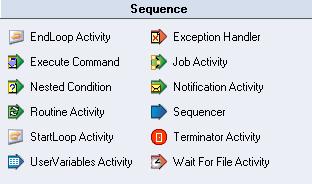
Sequence activity stage types
- Job Activity specifies a Datastage server or parallel job to execute.
- Notification Activity - used for sending emails to user defined recipients from within Datastage
- Sequencer used for synchronization of a control flow of multiple activities in a job sequence.
- Terminator Activity permits shutting down the whole sequence once a certain situation occurs.
- Wait for file Activity - waits for a specific file to appear or disappear and launches the processing.
- EndLoop Activity
- Exception Handler
- Execute Command
- Nested Condition
- Routine Activity
- StartLoop Activity
- UserVariables Activity